Some Observations on Telephoto
Photography
|
|
Dr Carlo
Kopp, AFAIAA, SMIEEE, PEng
Text, Images ¿ 2010 - 2013,
Carlo Kopp
|
Photosite count growth in consumer
and professional camera equipment between 2000 and 2010. While a
doubling law clearly applies, the doubling rate is around 4.5 years,
nearly three times slower than processing chip density growth (Author,
IO Journal, 2010).
|
|
|
Moore's
Law and its Impact on
Digital Imaging
|
|
Introduction
Moore's
Law is an acknowledged reality in the computer and digital
communications industries, and is reflected in the exponential growth
of chip densities, with a “doubling period” of 18 to 24 months. This
“law” will persist until either basic physics limits are
encountered in further shrinking semiconductor switches, or the
high profitability in further density improvement ceases.
Imaging chips in camera equipment, manufactured using the same MOS
technology processes, also exhibit exponential growth. However, imaging
chips, whether CCDs or CMOS imagers, have to also meet challenging
optical performance requirements, mostly in the ability to capture
photons. The result of this is that the doubling period in imaging
chips is much greater, in fact empirical data suggesting 2-3 times
slower density growth than in computing chips manufactured in the same
technology.
Until recently, Moore's Law was seen mostly as a good thing in the
photographic equipment and end user communities, as more pixels means
better definition and better detail in pictures, and thus all else
being equal, better quality.
This is contingent upon one condition, which is that the lens can
capture spatial frequencies in the picture which are equal to or higher
than the spatial frequency limit
determined by the pixel count in the imaging chip, and the effects of
Bayer pattern colour sampling and anti-aliasing filters.
What happens if the lens does not have adequate “bandwidth”
to match the Megapixel count and thus imaging photosite density of the
camera's imaging chip?
To any experienced photographer, this is simply a rhetorical question.
The result, inevitably, is that the picture is “soft”
or lacks sharpness and thus fine detail is lost.
The subject of sharpness in lenses has been debated and argued in the
photographic community ad nauseum, and has been the cause of many a
techno-religious war or schism between advocates of various lenses or
manufacturers.
In the era of wet film cameras, the spatial frequency limits of the
film imaging medium were essentially determined by the grain size in
the film, which has improved progressively over the decades, but never
exponentially. Exponential growth is not a feature of the processes
used in producing fine grained optical films.
In the “digital age”, exponential growth is for the
immediately foreseeable future an unavoidable reality.
The material reality is that a great many low cost commodity cameras
already have imaging chips which can capture significantly higher
spatial frequencies, through high Megapixel counts, than the installed
lenses can realistically support. In other language, the “spatial
frequency domain bandwidth”, to coin a term, of the chip is higher than
that of the lens. The lens becomes the performance bottleneck in the
imaging system.
Until recently, in professional digital photographic equipment, lens
performance was mostly not the critical limitation in optical
performance of the camera system - the density of the imaging chips was
simply not high enough to exceed the performance of the lenses.
This changed when the first high performance digital backs appeared
some years ago in
the market, for medium format Hassellblads and Mamiyas, offering more
than 20 Megapixel resolution. Professional landscape photographers were
the first to state concerns, mostly about soft corners. More recently,
there
has been considerable discussion concerning the 24 Megapixel Nikon D3X
body, as some users found their preferred lenses no longer performed
adequately.
The recent release of Nikon's 36 Megapixel D800/D800E full frame DSLR
body
priced
around US$3,000 per unit will change all of this, since it shifts the
threshold from camera systems in the $10,000+ class down to the $3,000
class, which is accessible to smaller turnover professionals and
semi-professionals, and well funded enthusiasts. Suffice to say other
manufacturers will in short order offer similar designs - that is the
nature of a competitive market.
What will be observed is that a large proportion of the lower and
mid-range professional and high end amateur lenses will not perform
adequately with 24 - 36 Megapixel bodies, and indeed the higher
resolution bodies which will follow. PhaseOne and Leaf are now offering
80 Megapixel digital backs for medium format cameras, so the trend is
well established. Mamiya released recently improved “digital”
variants of key lenses in their product line, with improved but
unstated sharpness performance.
The question of course is which of the current and older lenses in use
by the broader photographic community will be adequate for the coming “Megapixel
deluge” as the market's insatiable greed for Megapixel counts drives
mid range professional, and later top end amateur camera bodies into
the 20+ Megapixel bracket?
More importantly, which category of lenses will hit the “spatial
frequency domain bandwidth” bottleneck first?
The answer is, to any experienced photographer, the category of
telephoto lenses, which have historically been the most expensive for
any given f-number. The simple reality is that the optical quality of
lenses for longer focal lengths must be higher to achieve equal
sharpness to a standard lens. Chromatic aberration is also a pronounced
problem in telephotos, which is why apo-chromatic designs
are more frequent in telephotos. Often a serious chromatic aberration
problem will do more damage to an image than poor sharpness.
The intent behind this short study was to look at the category of
telephoto
lenses which is most exposed, which are smallest, lightest and
frequently most popular high end amateur, semi-professional and
professional telephotos, be they primes or zooms, used in sports,
wildlife, train, car-race, aviation and military photography.
Photographic
Technique to Maximise Sharpness
With any high quality lens, extracting the full performance potential
of the glass requires proper technique. Especially important is shutter
speed, as any motion of the camera boresight
while the shutter is open will cause smearing of the image. If the
angular motion of the camera boresight subtends much less than a single
pixel, the image will appear to be sharp, with a sharp lens. Otherwise
sharpness is lost.
Telephoto lenses are the most problematic, as the narrow angular
coverage of the lens, compared to wide angle, standard angle and
portrait lenses dramatically increases susceptibility to “user
induced motion blur” or technically, “boresight
jitter”.
Experienced telephoto users, especially those who have used film,
appreciate the implications of this - for most circumstances, the
optimal aperture for lens sharpness and depth of field, combined with
the short exposure times of 1/1000 or less, drives the optimal exposure
into high ISO values. This means 400 - 1600 ISO is not uncommon in
telephoto shooting.
The alternate strategy, to avoid the grain of high ISO film or noise of
high ISO digital imaging, is to attempt to minimise motion of the
camera. This results in the use of tripods, mirror locks, or in
extremis hanging weights under a tripod to increase its stability and
suppress mirror induced motion. This is also infeasible for the type of
handheld shooting which is common in wildlife, sports and other related
styles of photography. Monopods are an option, but not always as
flexible as handheld.
In handheld photography, the play is primarily about finding the
sharpest telephoto lens light enough for handheld use, selecting the
optimal
aperture for best sharpness, finding a camera with minimal noise at
high ISO settings, and configuring the camera to perform best in this
regime.
The great advantage of digital over wet film in
telephoto shooting is that sensitivity or ISO in modern cameras can be
configured to dynamically adjust on a frame by frame basis, unlike film
where ISO is fixed by the loaded roll. Therefore, in getting optimal
exposure, the photographer can fix the aperture setting, and the
shutter speed both for optimal results, and let the automated metering
adjust the ISO to get the proper exposure.
This will not always work perfectly, as most cameras with “Auto-ISO”
may not have fine control of the ISO value, so in the end the camera
must be left in Aperture Priority mode, and bounds set on the “Auto-ISO”
control to prevent the shutter speed dropping below some limit. In this
regime, the camera metering system will use ISO value for coarse
exposure control, and shutter speed for fine control. There are
pragmatic limits - if the scene is too bright, ISO may hit the lower
limit for the camera, and shutter speed the upper limit. The converse
is also true in a poorly lit scene, where the automation will drive the
ISO into high values with high noise, while the shutter speed is stuck
at the lower limit for the focal length.
Many authors of texts on photography, bloggers and other “authorities”
frequently reject the use of the “Auto-ISO”
control, which is unfortunate, since this is the one unique feature of
digital photography which has the single greatest potential to improve
the general quality of telephoto shooting. Manufacturers who have
incorporated “Auto-ISO” controls with shutter speed
limits clearly do understand and appreciate the value of this feature.
It does not appear to be well appreciated outside of the small
community of experienced professional telephoto shooters.
Comparing
Lens Sharpness
While an experienced photographer can quickly assess
the relative sharpness performance of any given collection of lenses by
carefully looking at imagery produced, the fastest and often easiest
way is to look at test results.
There are three large databases of lens tests on the web, maintained by
Photozone.de,
SLRGear,
and DXO
Labs, and many more other sites which include test data on various
lenses. Across these databases, hundreds of lens types are covered,
although many older lenses and high performance professional lenses are
not covered.
There are numerous metrics of lens sharpness in use, and it is
necessary to compare apples with apples, in the sense that
like metrics must be used. The lowest common denominator is the very
old wet film era metric of line pairs (or lines) per millimetre, i.e.
lp/mm, which is
not the most popular at this time.
An important caveat to consider is the camera body used in the test.
The limitation to such tests is invariably imposed by the number of
Megapixels the camera body can capture. Spatial frequencies passed by
the lens which are above the anti-alias filter and imaging chip limits
are lost in the measurement - effectively the camera body is blind to
spatial frequencies above its sampling capability. It is worth
observing that the imaging chip in a 24.5 Megapixel D3X has a sampling
limit of ~82 lp/mm, while the chip in the 36.3 Megapixel D800 has a
sampling limit of ~102 lp/mm, using the Nyquist criterion. The 16
Megapixel D7000 with an APS-C chip has slightly higher density than the
D800, but exploits the centre “sweet spot”
in full frame lenses.
This effect is very apparent on the DXO database,
where test results produced with a 24 Megapixel body are clearly
better, for the same lens, than results produced using an 8, 10 or 12
Megapixel body. This effect can be observed wherever any given higher
performance lens has
been tested on bodies with different Megapixel counts. Where the camera
bodies have similar Megapixel counts, the difference in the measurement
results may be small or negligible, but where the difference is large,
the results may not make for accurate comparisons.
The table below, entitled “Comparative 300-400 mm Lens Peak
Centre Resolution Performance” is compiled from data across a wide
range of databases, all converted to lp/mm for convenience. It should
be treated with caution, for all of the previously stated reasons, but
also due to the tolerancing variations between lens examples used for
testing. Some samples will have been at the upper performance limit for
the type, some typical, and some at the lower end. This is a simple
reflection of the fact that production lenses are typically normally
distributed and follow a bell curve. While the data has been checked by
looking at sample images where available, not all of the lenses in the
table could be checked in this fashion, especially older lenses.
One observation, well known to experienced telephoto users, which is
not clear from tabulated measurements, is that most zooms suffer the
most performance loss in the last 100 mm of the zoom range. It is a
standing anecdote in some parts of photographic community, that the “Company
X 100 - 500 mm f/6.3 zoom is really a 150 - 400 mm zoom ...”,
and therefore to get some nominal focal length out of a
zoom with good quality, it is necessary to use a zoom lens with a
nominal maximum around 100 mm greater than the required maximum. Paraphrasing
one blogger, “...the last 100 mm are for emergency use only...”.
What the table does show, for “handheld use compatible”
telephoto lenses, is that high performance professional
lenses will perform well on 20+ Megapixel camera bodies, but also that
the performance of many basic and semi-professional lenses may be
borderline with such camera bodies. Generally, lenses
with identical
focal lengths and maximum apertures tend to similar performance, unless
there are major design differences such as apochromatic optics.
While the Bayer pattern and resulting 1.414-fold reduction in sampling
density for green pixels provides a little headroom in real world
images, compared to monochrome test patterns, the inevitable reality of
the coming “Megapixel
deluge” does not change.
The yet to be answered question is the extent to which the photographic
equipment industry plan to address the developing performance gap
between
emerging high production volume 20+ Megapixel
camera bodies and “handheld
use compatible”
telephoto lenses.
|
|
|
|
Reading/Sites:
- Emil Martinec, Noise,
Dynamic Range and Bit Depth in Digital SLRs, Enrico Fermi
Institute, University of Chicago;
- Norman Koren, Blur units, MTF, and DXO
Analyzer’s BxU, Imatest Website;
- Rafael Zwiegincew, Pixel Peeper;
- Kopp C., Exponential growth laws in basic
technology and capability surprise, IO Journal,
Vol 2, Issue 4, Association of Old Crows, USA, pp. 21-27.
|
|
|
|
|
Comparative
200-400 mm Lens Peak Centre
Resolution
Performance
|
Lens
|
Sharpness
@ FL f/8
|
Sharpness
@ FL
f/8 |
AF
|
APS-C
FL [mm]
|
Filter ∅
[mm]
|
Mass
[kg]
|
Test Data
Source
|
Maximum
FL
|
Minimum
FL
|
Sekor C 105-210 mm f/4.5 ULD
|
62.0 @ 210.0
|
72.0 @ 105.0 |
M |
315.0
|
58.0
|
0.88
|
PP
1991 |
Nikkor AF-S 70-200mm f/2.8G
ED VR II
|
80.4 @ 200.0 |
83.9 @ 70.0 |
A |
300.0 |
77.0 |
1.54
|
PZ/Imatest |
Nikkor 70-300 mm f/4-5.6D ED
|
55.0 @ 300.0
70.0 @ 300.0E |
64.0 @ 70.0
76.0
@ 70.0
|
A
|
450.0
|
62.0
|
0.52
|
DXO
CO-NET
|
Nikkor 70-300mm f/4.5-5.6G
ED VR
|
68.1 @ 300.0
53.0
@ 300.0
|
77.0 @ 70.0
65.0
@ 70.0
|
A |
450.0 |
67.0 |
0.745 |
PZ/Imatest
DXO
|
Tamron 70-300mm f/4-5.6
SP Di
VC USD
|
68.1 @ 300.0 |
78.9 @ 70.0 |
A |
450.0 |
62.0 |
0.765 |
PZ/Imatest |
| Tokina 80-400 mm f/4.5-5.6 AT-X 840 AF D |
56.0 @ 400.0E |
76.0 @ 80.0 |
A
|
620.0 |
72.0
|
1.02
|
CO-NET
|
Nikkor 80-400 mm f/4.5-5.6D
ED
VR
|
60.0 @ 400.0 |
61.7 @ 80.0 |
A
|
620.0
|
77.0 |
1.34
|
PZ/Imatest |
Canon 100-400 mm f/4.5-5.6
USM L IS
|
64.7 @ 400.0
71.0 @ 400.0 |
69.4 @ 100.0
76.0 @
100.0 |
A
|
620.0 |
77.0 |
1.36
|
CO-NET |
Sigma 120-400mm f/4.5-5.6
APO
|
62.4 @ 400.0E
59.5 @ 400.0E |
66.5 @ 120.0
76.0
@ 120.0
|
A |
620.0 |
77.0 |
1.75
|
PZ/Imatest
CO-NET
|
Sigma 150-500mm f/5-6.3 APO
|
68.0 @ 400.0E
59.0 @
500.0E
62.9 @
500.0E |
76.0 @ 150.0
65.4 @
150.0
|
A |
750.0
|
86.0
|
1.91
|
CO-NET
PRC Unsp
|
Tamron 200-500mm f/5-6.3 SP
Di LD IF
|
57.2 @ 500.0E
59.1 @
400.0
|
63.3 @ 200.0 |
A
|
750.0 |
86.0 |
1.24
|
PZ/Imatest |
|
|
|
|
|
|
|
|
Sekor A 200 mm f/2.8 APO
|
80-120 @ 200.0 |
N/A
|
M
|
300.0 |
77.0 |
1.10 |
Mamiya
|
| Sekor C 210 mm f/4N |
78.0 @ 210.0 / f4
|
N/A |
M |
315.0 |
58.0 |
0.715 |
PP
1991 |
Sekor C 300 mm f/5.6N ULD
|
~80.0 @ 300.0 |
N/A |
M |
450.0 |
58.0 |
0.710 |
Estimated |
Nikkor 300 mm f/4.0D ED IF
|
65.8 @ 300.0
|
N/A |
A |
450.0 |
77.0
|
1.44
|
PZ/Imatest |
| Nikkor 300 mm f/4.0 ED IF |
~65 @
300.0 |
N/A |
A |
450.0 |
82.0
|
1.33
|
Estimated |
Nikkor 300 mm f/4.5 ED AI-S
|
60+
@ 300.0 |
N/A |
M
|
450.0 |
72.0
|
1.20
|
Estimated |
| Nikkor 300 mm f/4.5 ED IF
AI-S |
60+ @
300.0 |
N/A |
M |
450.0 |
72.0 |
1.06
|
Estimated |
| Nikkor 400 mm f/5.6 ED IF AI-S
|
60+ @
400.0
|
N/A |
M |
620.0 |
72.0 |
1.20 |
Estimated |
Canon 400mm f/5.6 USM LF
|
65.4 @ 400.0
|
N/A |
A |
620.0 |
77.0 |
1.25
|
PZ/Imatest |
Sigma 400mm f/5.6 APO TMF
|
64.2 @ 400.0 |
N/A |
A |
620.0 |
77.0 |
1.29
|
PZ/Imatest
|
|
|
High Performance Professional
|
>
75 [lp/mm] |
|
|
|
|
|
|
Basic Professional
|
60
- 75
[lp/mm] |
|
|
|
|
|
|
Semi
Professional
|
55
- 60 [lp/mm]
|
|
Sharpness
[lp/mm] @ FL [mm] : separation between two lines, -3 dB in contrast
/ MTF50; sometimes also described as lines /mm, this document follows
the same usage convention as the DXO website.
|
Notes:
- The
table is not intended to be exhaustive and is not, it is only intended
to provide basic comparisons of lens categories for 35 mm / full frame
DSLR lenses;
- Measurement
data was produced using a range of tools and camera bodies and thus
does not share a common baseline, some results will overstate
performance, and some understate performance; note that the higher the
sampling density of the camera, the more accurate the result, while
APS-C sensors yield better results than full frame sensors as the
inferior corners are not measured;
- Estimated
performance is based on the comparison of imagery produced by the lens
cf imagery produced by a lens of known (published) sharpness
performance - this technique is sensitive to camera quality and likely
underestimates actual performance;
- This
table should not be used for purchasing decisions, as these require
that the lens be assessed on the camera body to be employed, and
consider factors other than peak sharpness;
- Peak
sharpness at maximum zoom is at ~f/11.0, but f/8.0 at
lower zoom settings;
- The Canon 400mm f/5.6 USM L test was
performed using a Canon EOS 5D Mark II with 21.1 Megapixel 36 × 24 mm
CMOS sensor, while the Sigma 400mm f/5.6 APO Tele
Macro test was performed using an EOS350D with an 8 Megapixel 22.2 mm ×
14.8mm CMOS sensor;
- The
test data does not account for statistical variations in performance
across production runs; anecdotal reports for most of these lens types
suggest that spread, especially early in production runs, can be
significant; tests performed early in the life cycle of the product may
under- or over-represent typical performance by a larger amount than
tests performed on mature late production items, when the mature
process yields smaller variance in lens performance; it is not possible
to determine whether lenses provided by manufacturers for review and
testing were selected high performance outliers in the build.
|
|

Comparison of widely used current
production 400 mm f/5.6 class
telephoto lens centre sharpness, using Photozone and CO-NET (Sigma)
measurement results. The Sigma 120 - 400 mm APO zoom is excluded, as it
is outperformed strongly by its sibling 150 - 500 mm APO zoom at 400 mm
focal length. Notable is that the best performing designs are strongly
clustered at peaks around f/8.0, other than the unconventional Sigma
design, which is an outlier at f/11.0 and thus more demanding of sensor
noise performance to operate at this aperture. With full frame sensors
beyond 20 Megapixels, all of these lenses will be challenged to fully
exploit the sensor.
|
Comparative
Imaging Sampling Density
Performance
|
Camera Body/Back
|
Sensor Geometry
|
Sensor Size [Megapixels]
|
Pixel Density [lp/mm]
|
Green Density [lp/mm] |
Red/Blue Density [lp/mm] |
Notes
|
Nikon D700/D3
|
FX
|
12 |
59.2
|
41.8
|
29.6
|
|
Nikon D3X
|
FX
|
24 |
84
|
59.4
|
42.0
|
|
Nikon D90
|
DX
|
12 |
90.1
|
63.7
|
45.1
|
|
| PhaseOne IQ180 |
53.7 x 40.4 |
80 |
96.2 |
68.0
|
48.1
|
|
Nikon D800
|
FX
|
36 |
102.3
|
72.3
|
51.2
|
|
Nikon D7000
|
DX
|
16 |
104.6
|
73.9
|
52.3
|
|
|
|
|
|
|
|
|
The Bayer pattern to some extent
reduces the effect of lens limitations in real pictures, compared to
synthetic tests. This is because of the reduced sampling density for
green and red/blue pixels, versus absolute density. A more detailed
discussion can be found in Some
Observations on Digital vs Wet Film Photography.
|
Twenty
Empirical Observations on
Telephoto Lens Performance and Use
|
There are some ground rules which can aid
in getting good results in
telephoto shooting.
- The “sweet spot”
in sharpness for telephotos,
zoom or prime, is much more pronounced than in shorter lenses, with up
to 30 percent loss of peak sharpness in some lenses, and 15 percent
very common;
- Typical telephotos in the f/4 - f/6.3 range
are sharpest at f/8, some at f/11, the larger and heavier f/2.8
professional telephotos
tend to peak out most often around f/4;
- Most amateur and some “professional”
shooters attempt
to improve sharpness by aiming for low ISO settings, which for short
exposures like 1/500 - 1/2500 drives them to shoot wide open, where the
loss of lens sharpness does far more damage than the imaging chip noise
or film grain at higher ISO values;
- The combination of low shutter speeds and
aiming or sightline jitter, or other movement,
is the single biggest cause of poor sharpness in telephoto images;
- A reasonable rule of thumb is to use at
least 1/1000 at 200 - 300 mm, and halve the exposure
time in proportion to the increase in focal length - faster is better
until ISO impairs performance;
- Stabilised lenses are good at filtering out fine
jitter, less so gross jitter;
- Sharpness variations in zooms can be
prominent, with most zooms exhibiting a 16 percent loss of sharpness
between minimum and maximum zoom, although some amateur lenses are
worse, while some professional lenses significantly better;
- The more Megapixels a camera body delivers,
the sharper the lens needs to be to produce decent results - a 20
Megapixel or higher camera will require peak sharpness of 65 - 70 lines
/ millimeter to produce acceptable results, possibly more;
- Corner sharpness is important for some
telephoto subject matter, and is almost irrelevant for others;
- Lens
centre sharpness is most important in aviation, sports and wildlife
photography, where images are often cropped, in landscape photography,
sharp corners are a critical requirement;
- The old adage about “primes
being sharper than
zooms” is usually true in
telephotos, although often the biggest
difference is that primes have more consistent sharpness corner to
corner, while zooms even if matching the centre sharpness of a prime,
tend to softer corners;
- A 35 mm / full frame lens will usually perform
better on an APS-C sensor, as the sensor cannot see the softer corners;
a medium format lens will usually perform better on a full frame sensor
for the same reason, and even better on an APS-C sensor;
- Lens reputation and cost may not be good
indicators of optical performance, especially sharpness and chromatic
aberration; some expensive telephotos have borderline sharpness and
high chromatic aberration, some cheaper telephotos the opposite;
- Telephoto lenses are completely unforgiving
and will expose faults in technique, handling and camera setup far more
readily than any other common type of lens;
- Lens reputations often reflect ease of use
more than actual optical performance, care should be taken when
assessing
choices, some popular lenses are mediocre, some less popular lenses are
very good, even if more difficult to use;
- It is useful be very sceptical about opinionated
reviewers and carefully study their test methodology and thinking, as
often they can be seduced by brand names or features;
- The ultimate measures of worth in a telephoto lens
are sharpness, consistency of sharpness across the field, chromatic
aberration, distortion, and handling characteristics such as weight and
balance - careful tests are always more useful than subjective opinion;
- If test results are inconsistent, actual sample
photos should be studied carefully, as human testers are not infallible;
- High
ISO performance in a camera body is
necessary for telephoto shooting, and Auto-ISO is an essential feature.
This feature was absent in the era of wet film, when increasing ISO
performance meant swapping film
backs, or camera bodies.
- For any given technology used in the imaging
chip, in a DSLR a full frame sensor with larger imaging sites typically
outperforms an APS-C sensor; the tradeoff is always between lens corner
sharpness performance and higher sensor sensitivity performance.
|
Medium
Format Lenses and DSLR Bodies
|
|

Sources: Popular Photography; November 1999, April
2000, October 2002; Sharpness in lp/mm
In 2011 the author acquired a used Nikon D90
body primarily as an experiment to assess the practical problems in
exploiting medium format Mamiya-Sekor lenses on DSLRs, concurrently the
author
acquired a Fotodiox Pro Mamiya-Nikon mount adapter, which was modified
with a digital matrix chip to present as a Nikon lens.
Since then the D90 with Fotodiox adaptor has been used for a wide range
of test and practice, and some production shoots, using the following
lenses:
- Sekor C 45 mm f/2.8N;
- Sekor C 55 mm f/2.8;
- Sekor C 80 mm f/2.8;
- Sekor A 200 mm f/2.8 APO, also with one or two 2XN
teleconverters;
- Sekor C 105 - 210 mm f/4.5 ULD Zoom,
also with one 2XN teleconverter;
- Sekor C 210 mm f/4.0,
also with one 2XN teleconverter;
- Sekor C 300 mm f/5.6N ULD,
also with one 2XN teleconverter;
The choice of the semi-professional D90 was intentional,
since performance benchmarking suggested similar imaging performance,
at lower ISO to the professional D700. In addition, the D90 has an
internal focus drive motor permitting its use with older Nikkor and
third party telephoto lenses. This minimised the risk in the buy.
Results with the Mamiya-Sekor lenses exceeded expectations, as the
DX/APS-C sensor does indeed take full advantage of the sharper centre
of
the lens. All four prime lenses tested outperformed the 12.3 Megapixel
imaging system and would be suitable for use on a D3X class
body. The 105 - 210 mm f/4.5 ULD
zoom would need further testing with a higher resolution camera to be
conclusive, and would show its limitations beyond 16 Megapixels.
All lenses were used manual
focus designs acquired at
low cost, with the exception of the 80 mm f/2.8, acquired new in Tokyo,
in 1984.
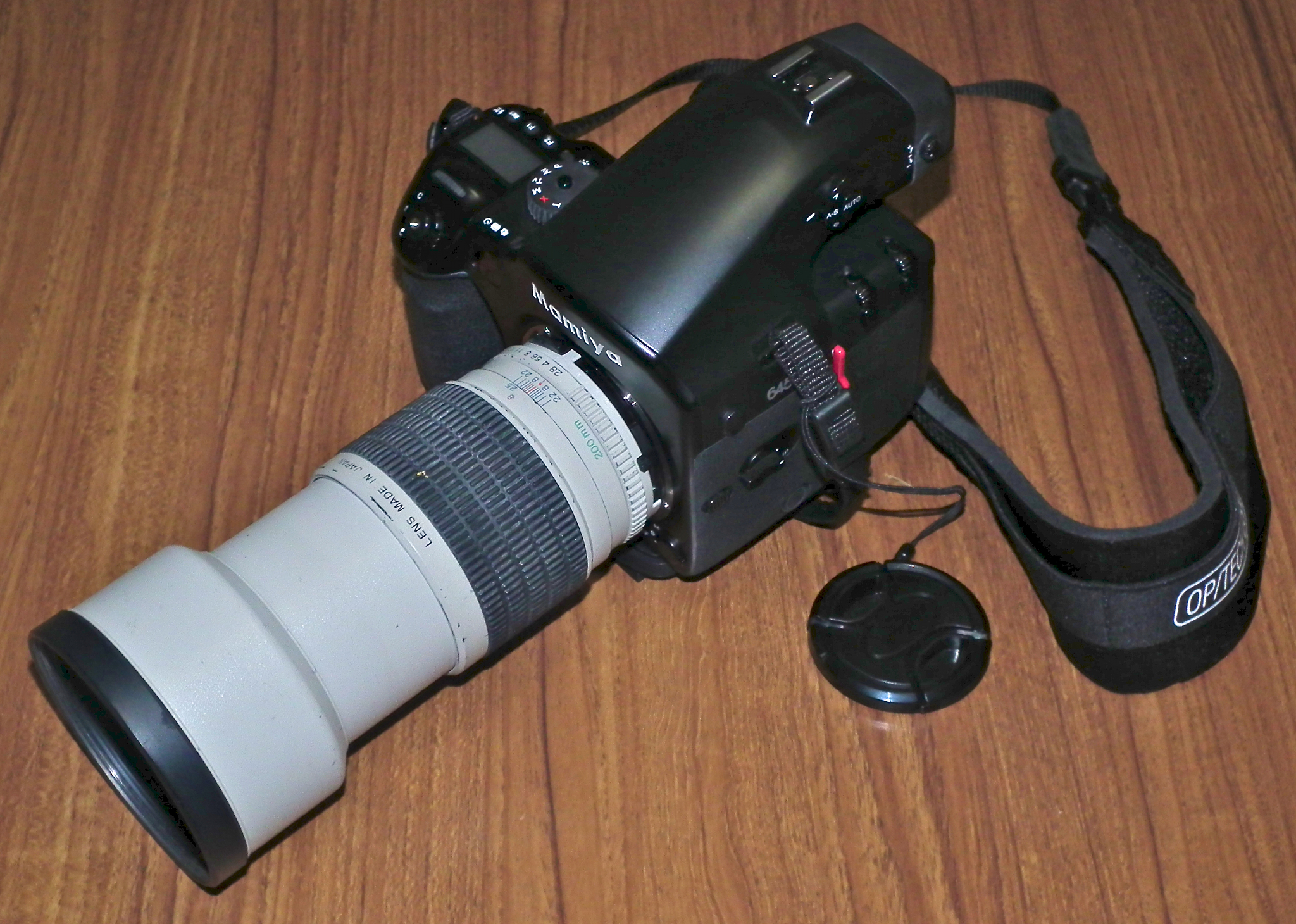
Sekor A 200 mm f/2.8 APO Lens
mounted on a Mamiya 645AFD (HS10 10 MP).
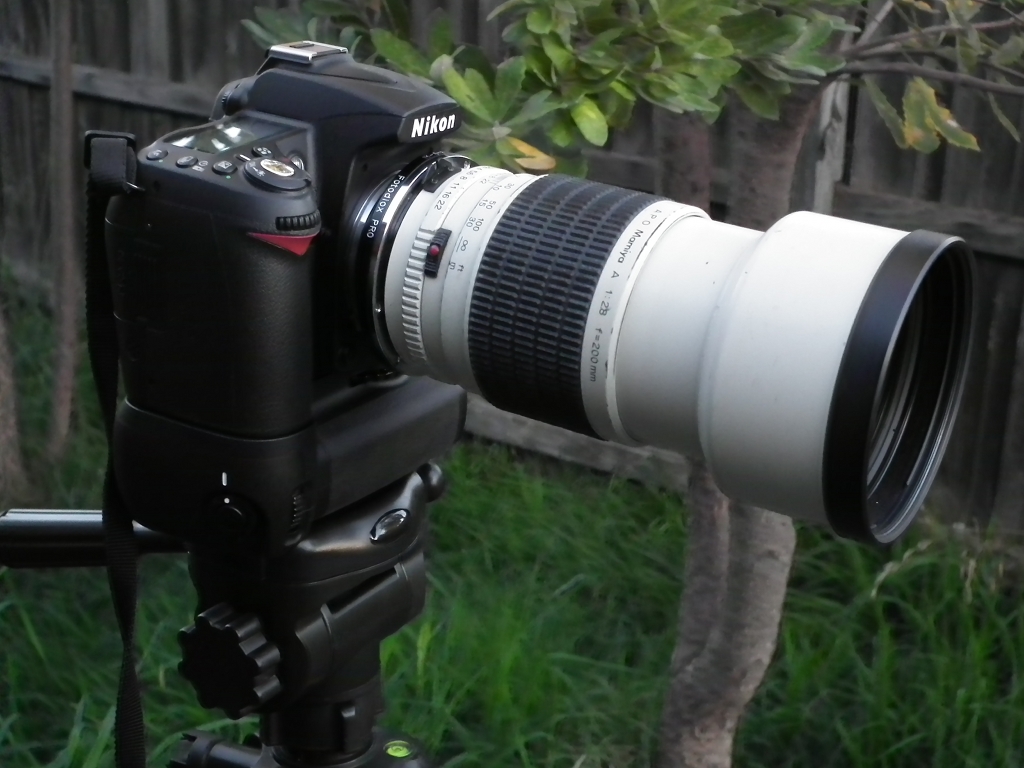
Sekor A 200 mm f/2.8 APO Lens
mounted on a Nikon D90/MB-D80 with a Fotodiox Pro adaptor (HS10 10 MP).
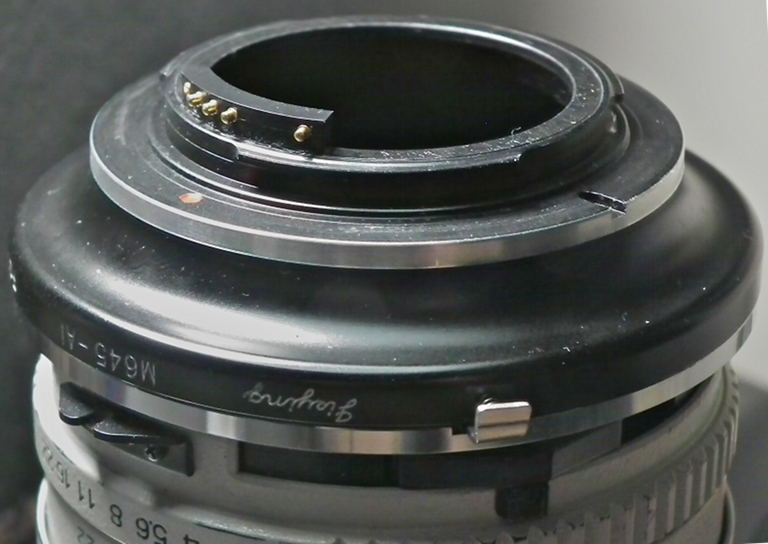
Fotodiox
Mamiya/Nikon adaptor modified by Legacy2Digital in the US with a
digital emulator chip, which presents the lens to the camera body as a
Nikon device. It is preprogrammed to represent the 200 mm f/2.8 APO
with the proper focal length and maximum aperture. This enables the
full range of automated features in a Nikon body, in this instance a
D90 (HS10 10 MP).
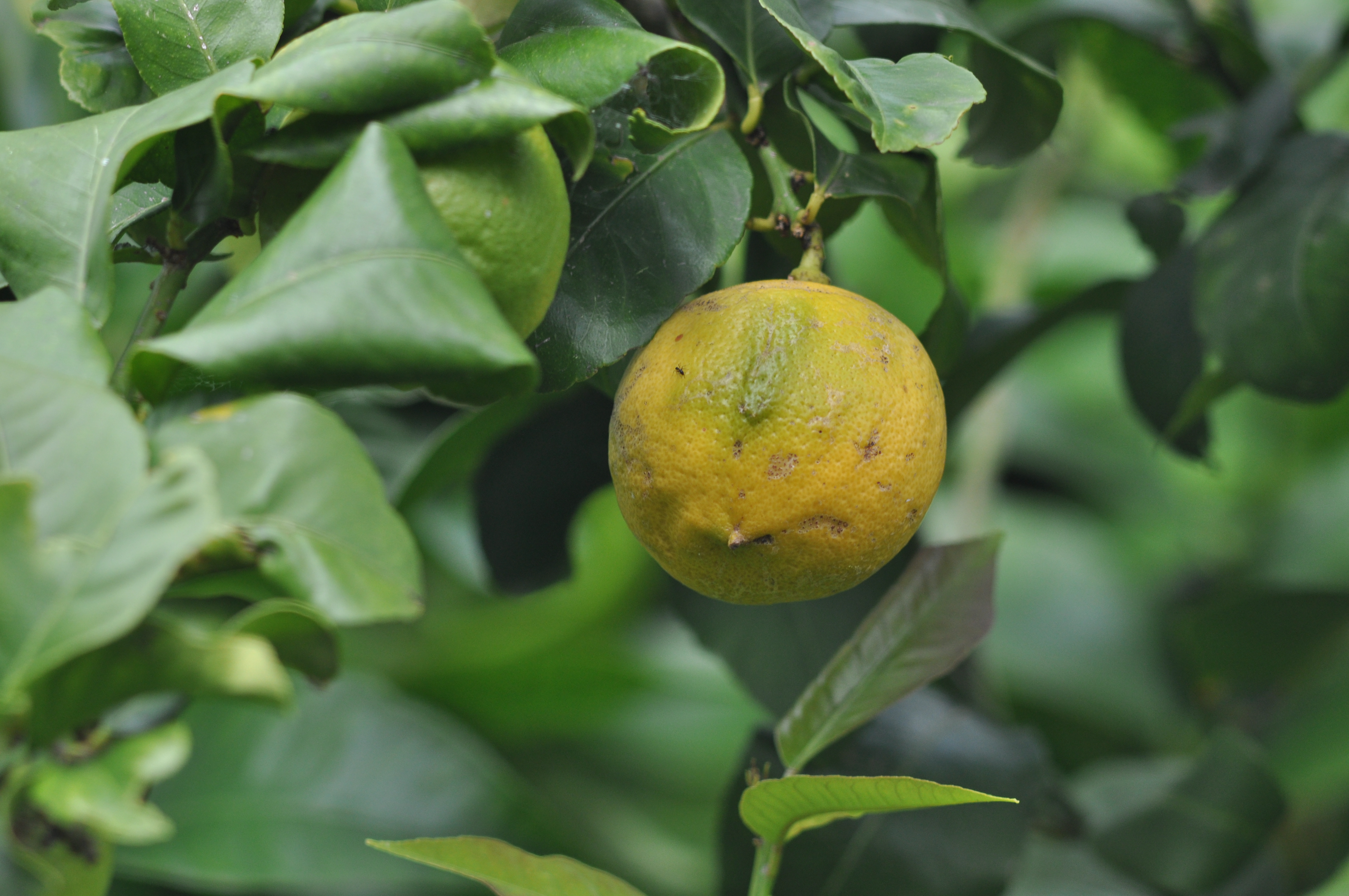
Above:
Test
target
using
the
200
mm
f/2.8
APO
manual
focus
lens
at
f/8.0
mounted
on
a
Nikon
D90 at 320
ISO and 1/500. Uncorrected 12.3 Megapixel
original. Handheld shot from ~2.5 metres [Click
image to view
full size]; note the
ant at full
size to the upper left of the lime fruit - the left antenna is
distinguishable, but the eyes are not.
Feline test target using the same
200 mm f/2.8 APO manual focus lens at f/5.6 mounted on a Nikon
D90 at 1100 ISO and 1/1600, using the Legacy2Digital modified adaptor.
12.3 Megapixel original cropped and adjusted for exposure using
Aperture 3. Note the reflection in the left eye at 1:1 [Click image to
view 1:1 resolution].

Test target (Plum blossom) using
the 200 mm f/2.8 APO manual focus lens mounted on a Nikon D90 at
400 ISO and 1/3200, using the Legacy2Digital modified adaptor. 12.3
Megapixel original cropped and adjusted using Aperture 3 [Click image
to view 1:1 resolution].
Meowing test
target
using the 105 - 210
mm f/4.5 ULD manual focus lens at 210 mm on a
Nikon D90 at 500
ISO and 1/1000, f/8.0. Cropped 20482 from 12.3
Megapixel
original, adjusted for exposure. Handheld shot
[Click image to view full size].

Test target using the 105 - 210 mm f/4.5 ULD manual focus lens at 210
mm with single M45 2XN teleconverter at f/8.0 mounted on a Nikon
D90 at 400 ISO and 1/800, adjusted for exposure. Above,
uncorrected 12.3 Megapixel original. This configuration produces
a focal length of 420 mm, equivalent to 630 mm on a 35 mm body.
Handheld shot [Click image to view full size].
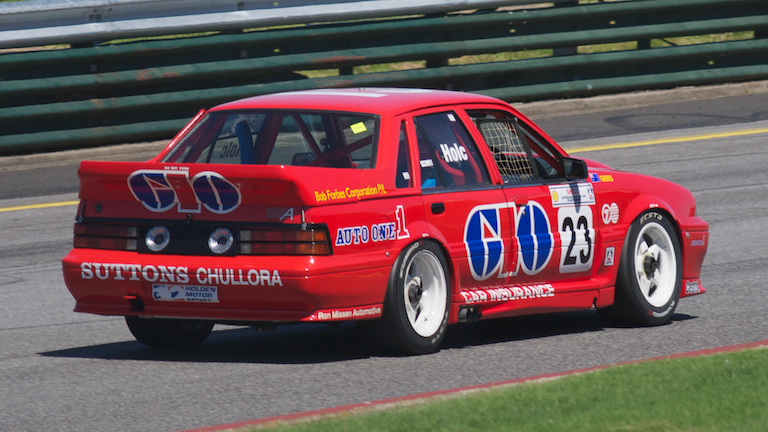
A pair of Australian racetrack classics at Sandown using the Sekor
C 300mm f/5.6N ULD telephoto prime, at f/5.6
mounted on a Nikon D90, at ISO 360 and 1/4000. This high contrast
manual lens is highly competitive against newer and much more expensive
Nikon and Canon telephoto primes. Best sharpness, like the shorter
Sekor C 210mm f/4.0 prime, is wide open. Handheld
shots.
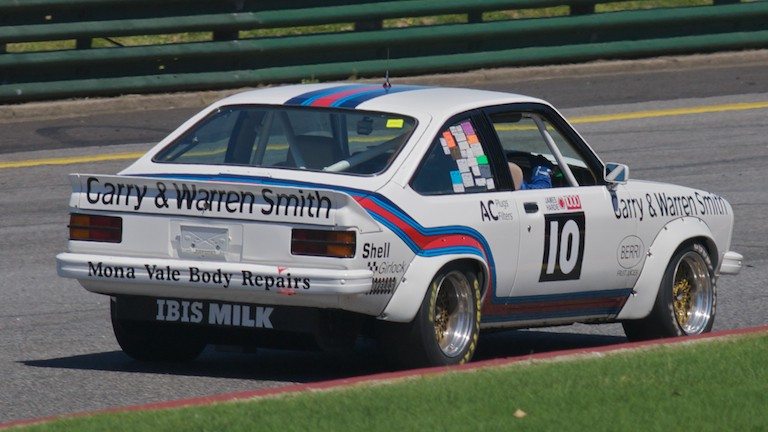
|
Nikkor
70-300 mm f/4-5.6D ED Imagery
Examples
|
|
Nikkor 70-300 mm f/4-5.6D ED
mounted on a D90/MB-D80.
The Nikkor 70-300 mm f/4-5.6D ED
telephoto zoom is a lightweight plastic barrel design with a
mechanically driven autofocus, which straddles
the semi-professional bracket upper boundary, and was obsoleted some
years ago. The
lens has an undeserved reputation for mediocrity, likely as its low
cost meant it was frequently used by inexperienced photographers - many
sample images on the web show evidence of poor aperture management,
with the lens operated wide open where its sharpness is especially
poor, and chromatic aberration very pronounced.
My motivation for
acquiring this frequently maligned lens was largely curiosity, as
DXOMark and SLRGear test
results suggested that at its optimal f/8.0 aperture it performed
competitively against much newer Nikkor 70-300 mm offerings, and used
examples were very cheap. This example including freight charges cost
$200.00. The results produced by this lens are often of sufficient
quality for less challenging professional applications, but it requires
careful handling and use at the optimal f/8.0 aperture value, with best
performance in the lower half of the zoom range. To date
this lens has been employed on the D90 and D800 body. Its performance
is borderline for 20+ Megapixel bodies, although samples produced using
the 36 Megapixel D800 appear to be of reasonable quality, albeit
requiring correction for chromatic aberration.

Comparison of recent DXO test data for the semi-professional/amateur
Nikkor 70-300 mm f/4-5.6D ED, and 1991 Popular Photography test data
for the mid-range professional Sekor C 105-210 mm f/4.5 ULD zoom
lenses. The Mamiya lens is always sharper for a given zoom ratio, and
has considerably better chromatic aberration performance at all focal
lengths.
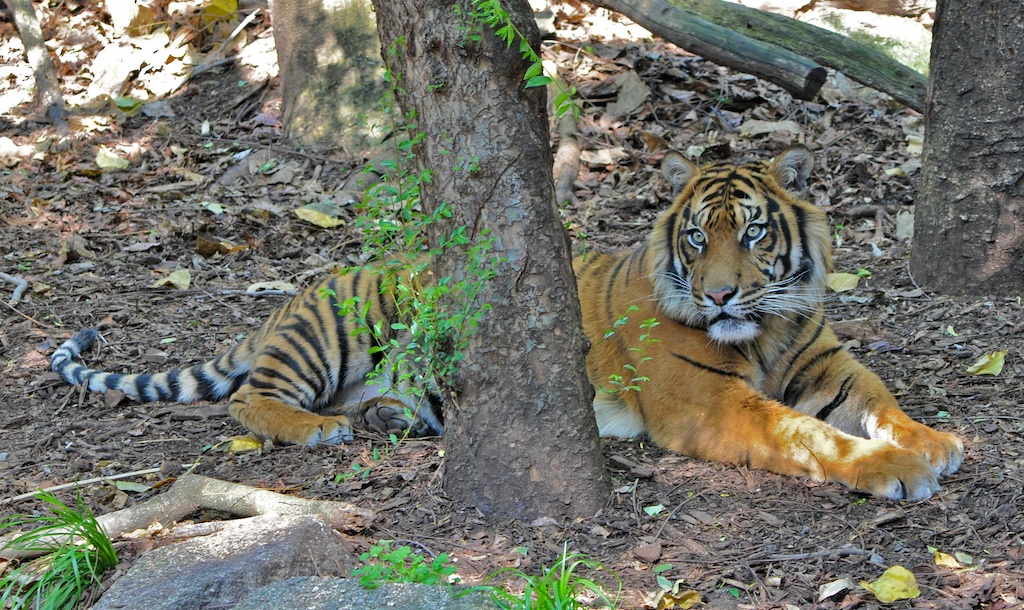
Sumatran
Tiger at Melbourne Zoo. Parameters: D90, f/8.0,
1/40, ISO 800, 0.0 EV, 135 mm. This image was one of few successful
examples, shot handheld, from a set in very poor lighting conditions
under a tree canopy.
|

Cheetah at Werribee Zoo. Parameters:
D90, f/8.0, 1/1000,
ISO 800, -0.66 EV, 165 mm.
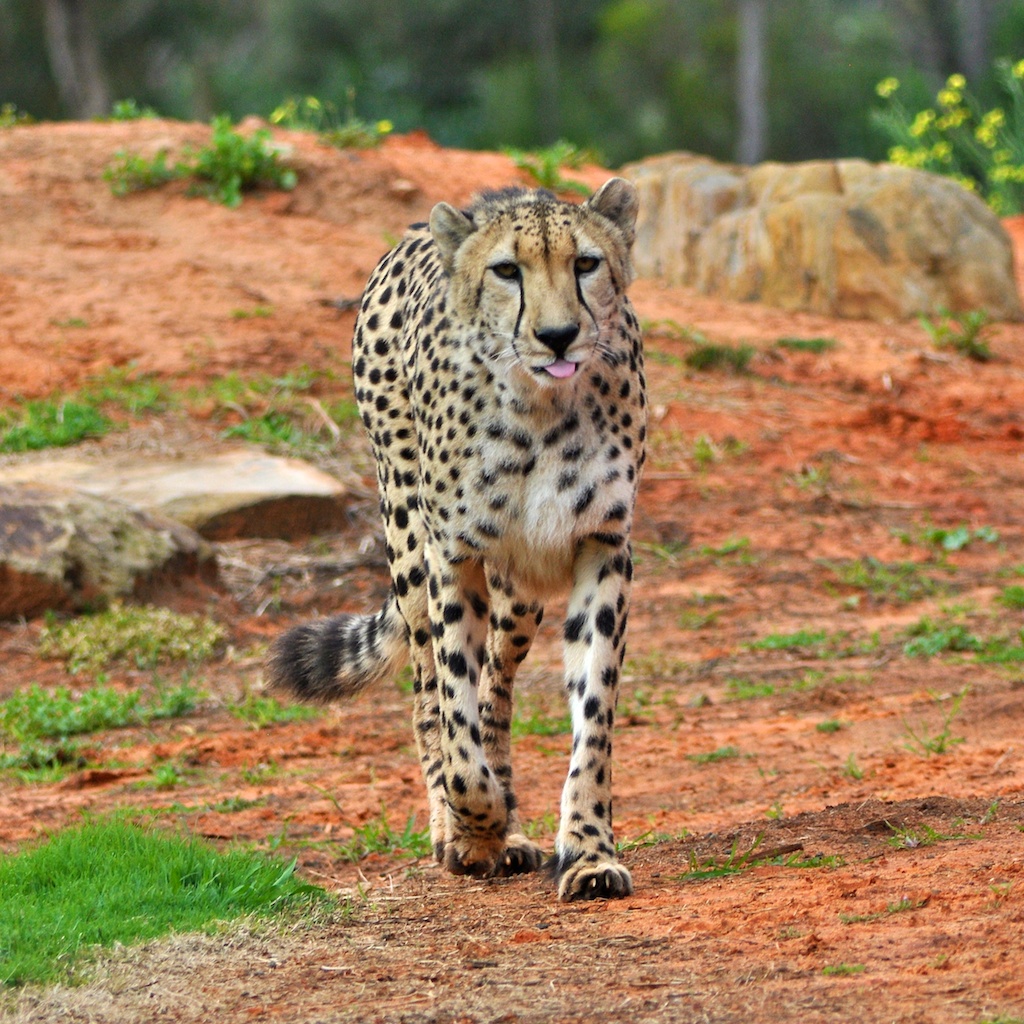
Cheetah at Werribee Zoo. Parameters: D90,
f/8.0, 1/1000, ISO
500, -0.66 EV, 300 mm.
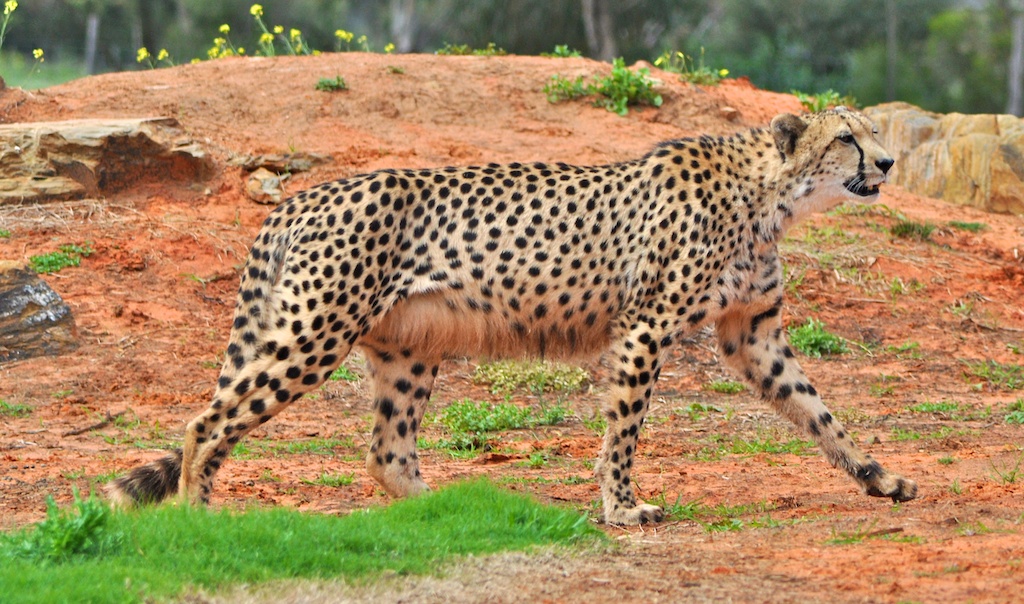
Cheetah at Werribee Zoo.
Parameters: D90, f/8.0,
1/1000, ISO 450, -0.66 EV, 240 mm.
|
African Wild Dog at Werribee
Zoo. Parameters: D90, f/8.0,
1/1000, ISO 720, -0.66 EV, 135 mm.
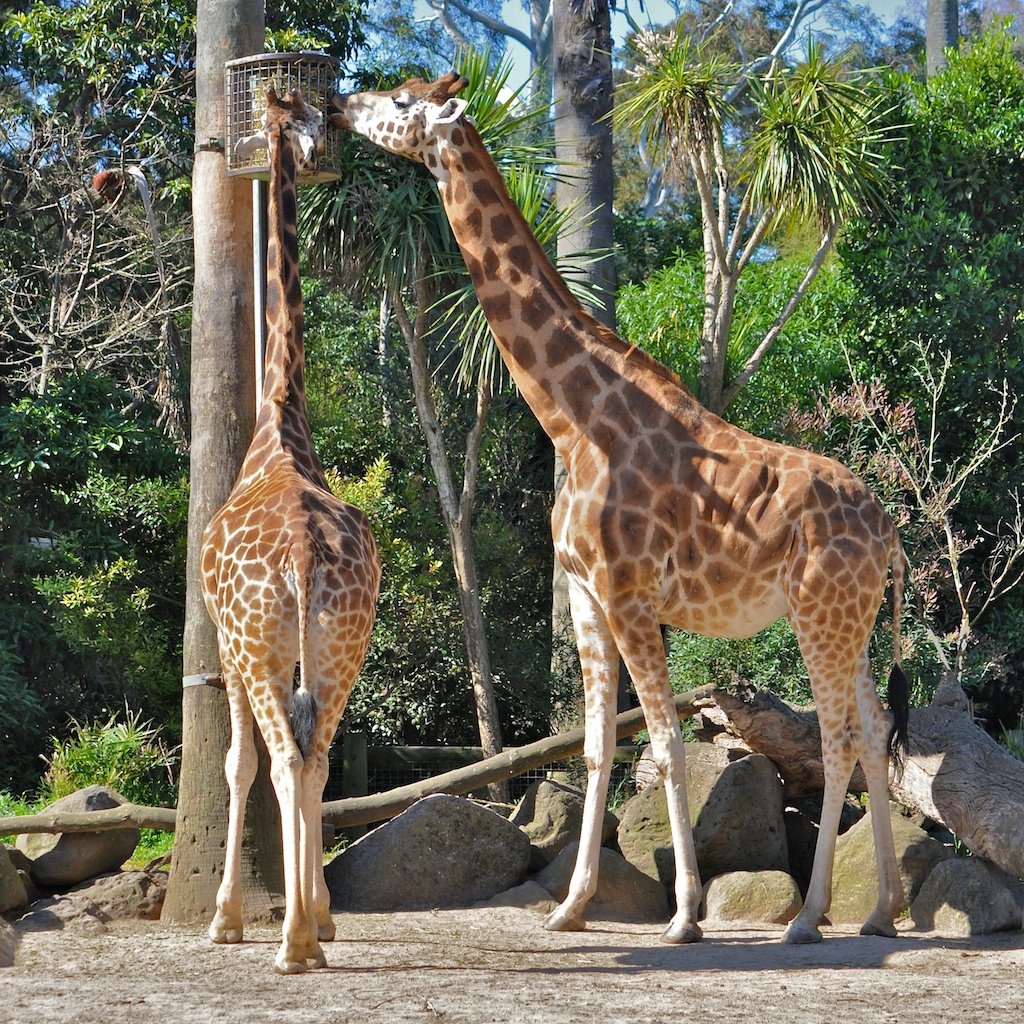
Giraffes at Melbourne Zoo. Parameters:
D90, f/8.0, 1/800,
ISO 800, 0.0 EV, 70 mm.
|
Eastern Grey Kangaroo at Cardinia.
Parameters:
D90, f/8.0, 1/1000,
ISO 500, 0.0 EV, 180 mm. Measurement
indicates centre sharpness of ~60 lp/mm in this configuration.
|
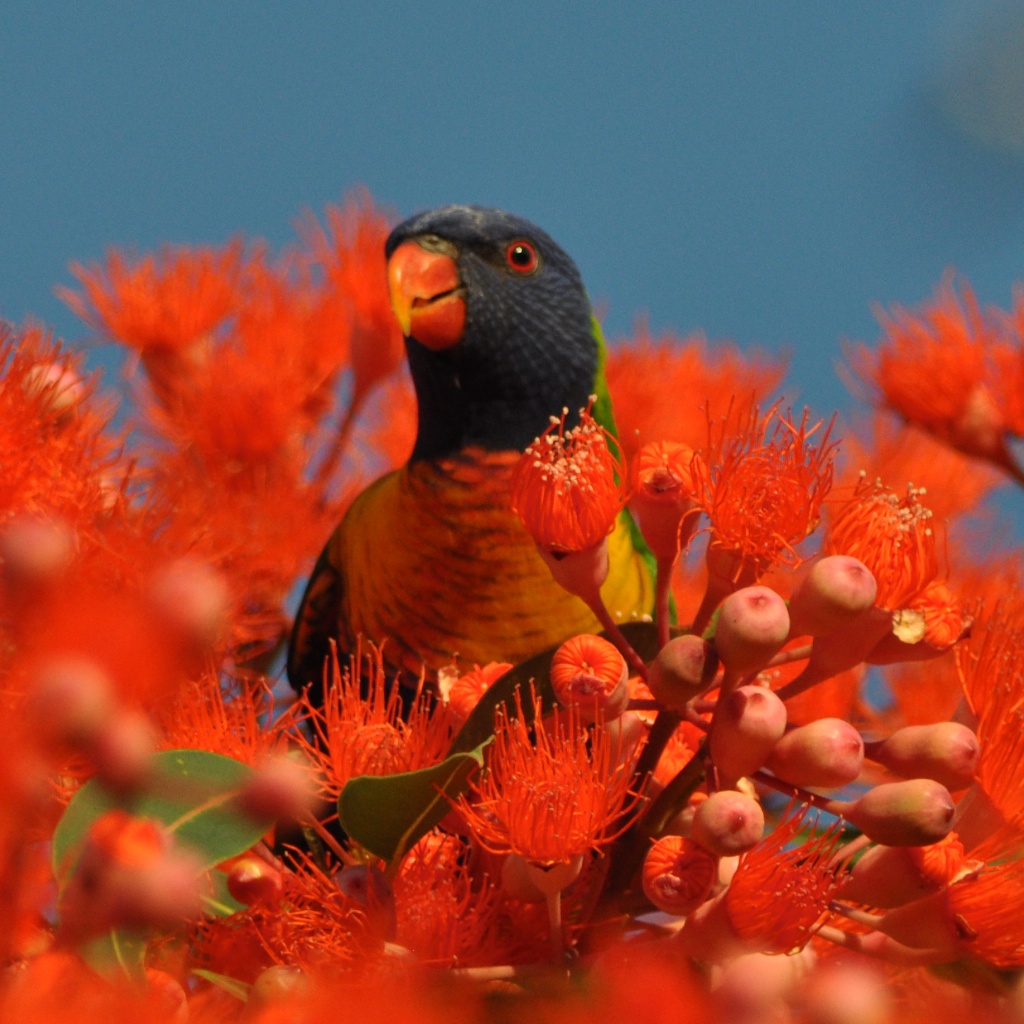
Rainbow Lorikeets in the suburbs
of Melbourne. Above: Parameters: D90,
f/8.0, 1/1000,
ISO 560, -0.66 EV, 300 mm; below: Parameters:
f/8.0, 1/1000, ISO 720, -0.66 EV, 300 mm.
|
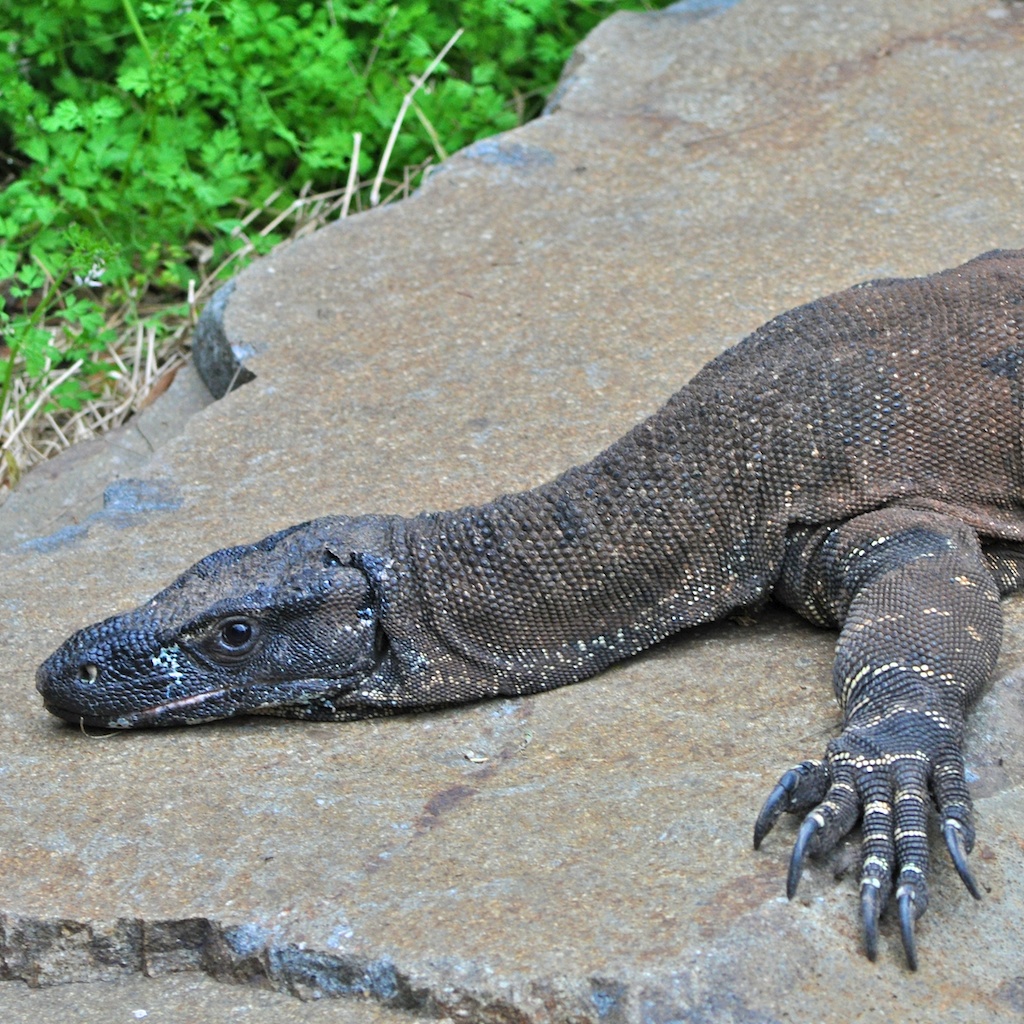
Lace Monitor at Werribee Zoo in
2011. Parameters: D90, f/8.0,
1/200, ISO 800, -0.66
EV, 190 mm.
The
common
Honey Bee - above 1:1 7682 crop of full frame, displayed
below. Parameters:
D90, f/8.0, 1/2000,
ISO 250, -0.66 EV, 200 mm. Measurement indicates centre
sharpness of ~60 lp/mm in this configuration.

|
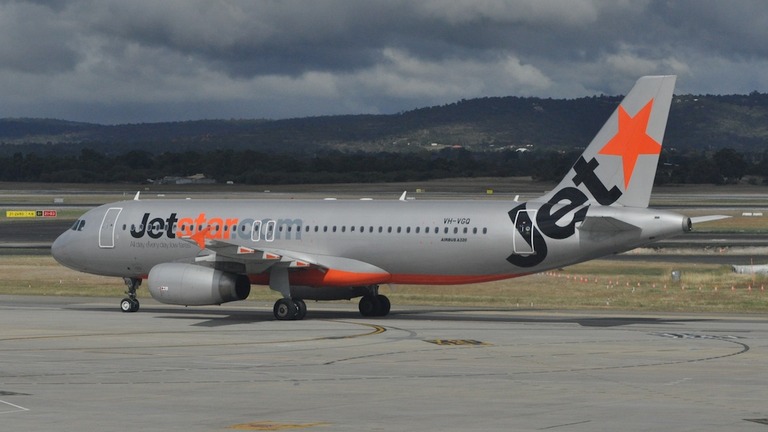
Jetstar A320-232 VH-VGQ at YPPH
November, 2011. Parameters: D90,
f/8.0, 1/3200, ISO
800, -0.66 EV, 70 mm.
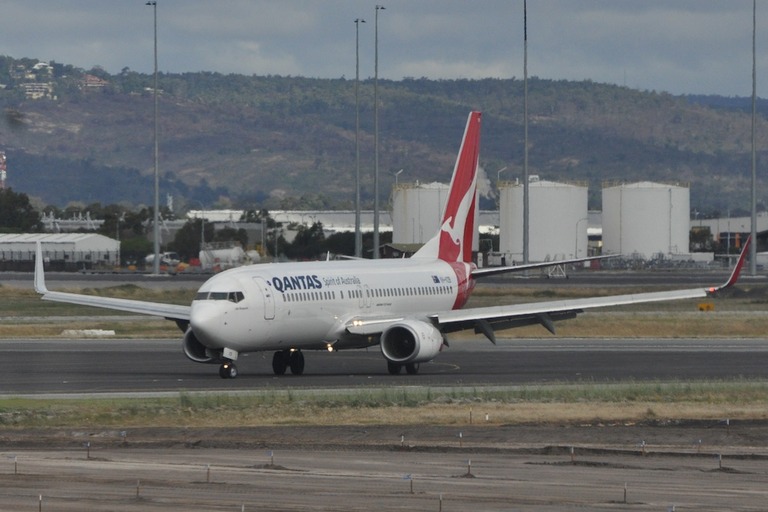
Qantas 737-838 VH-VZB at YPPH
November, 2011. Parameters: D90,
f/8.0, 1/1600, ISO
800, -0.66 EV, 190 mm.
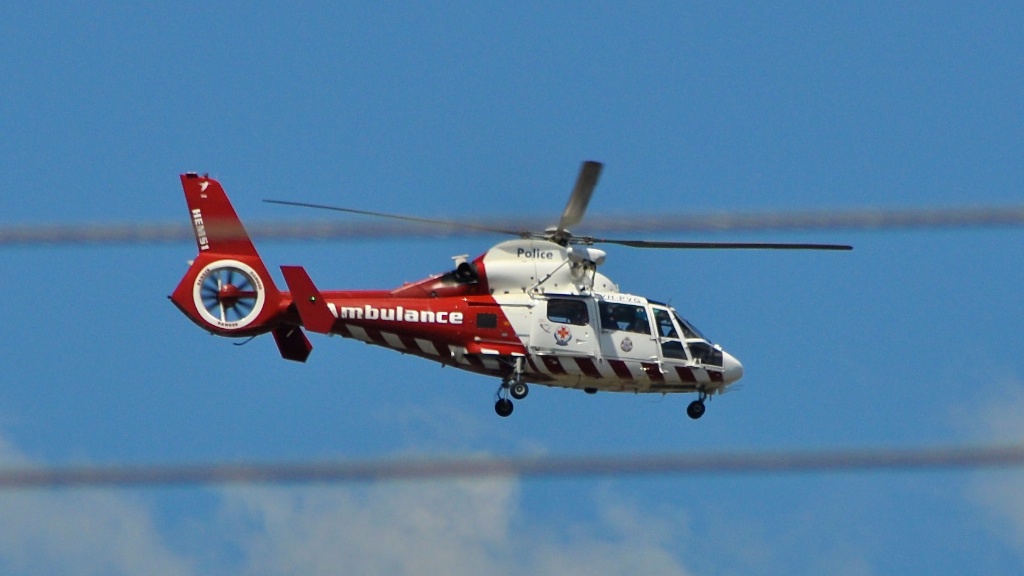
Polair 33 VH-PZG, configured as an
air ambulance, over the eastern suburbs of Melbourne in December, 2011.
Parameters: D90,
f/8.0,
1/1600, ISO 200, -0.66 EV, 300 mm.
 Transformer pole in the eastern suburbs of Melbourne in
September, 2013. Parameters:
D800, f/8.0,
1/2000, ISO 560, 0.0 EV, 300 mm. Below 1024^2 pixel 1:1 crop.
Transformer pole in the eastern suburbs of Melbourne in
September, 2013. Parameters:
D800, f/8.0,
1/2000, ISO 560, 0.0 EV, 300 mm. Below 1024^2 pixel 1:1 crop.


Ceramic pig on roof. Parameters: D800,
f/8.0,
1/2000, ISO 500, -0.33 EV, 300 mm. Below 1024^2
pixel 1:1 crop.

 Grevillia Banksii blossom. Parameters: D800,
f/8.0,
1/1250, ISO 1250, -0.33 EV, 240 mm. Below 1024^2
pixel 1:1 crop.
Grevillia Banksii blossom. Parameters: D800,
f/8.0,
1/1250, ISO 1250, -0.33 EV, 240 mm. Below 1024^2
pixel 1:1 crop.

 VHF/UHF television antenna. Parameters: D800,
f/8.0,
1/2000, ISO 500, -0.33 EV, 100 mm. Below 1024^2
pixel 1:1 crop.
VHF/UHF television antenna. Parameters: D800,
f/8.0,
1/2000, ISO 500, -0.33 EV, 100 mm. Below 1024^2
pixel 1:1 crop.

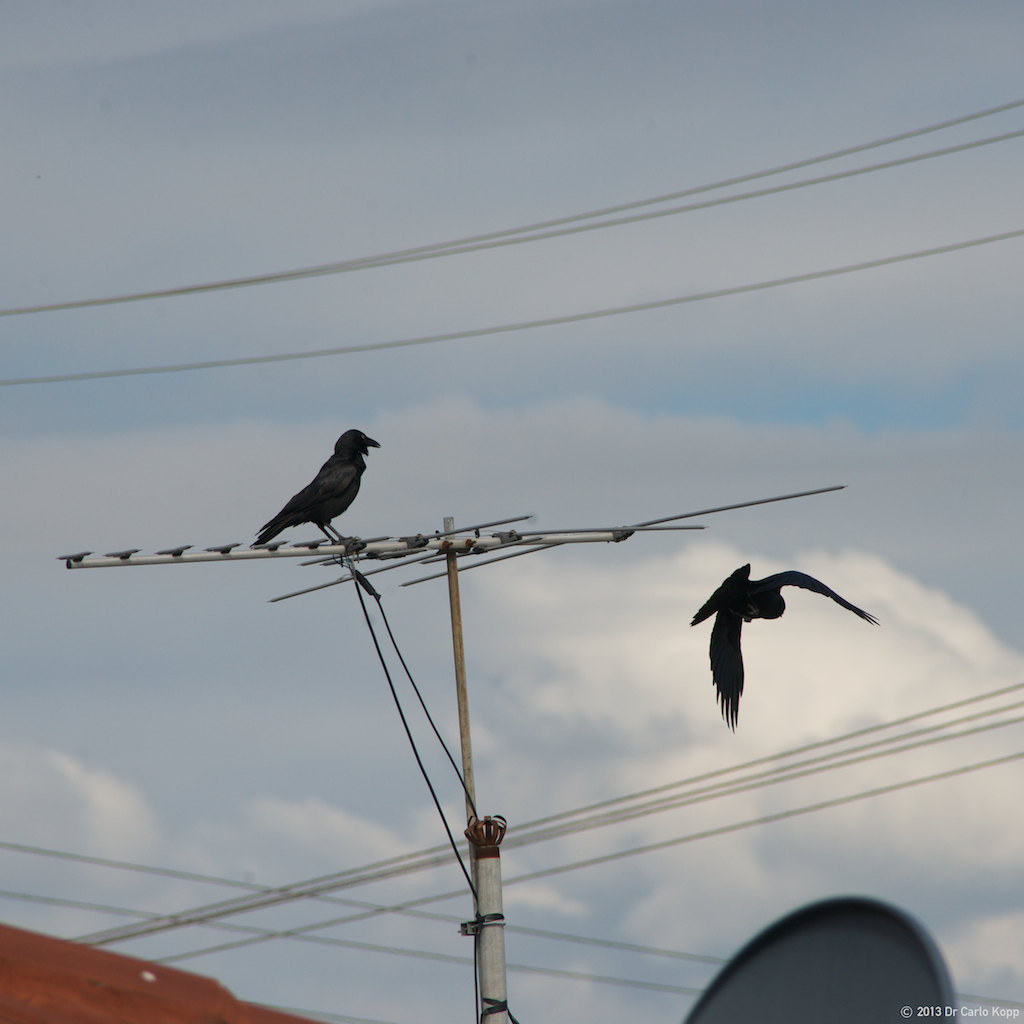 A pair of Little Ravens on a television antenna, one
departing. Parameters: D800, f/8.0,
1/3200, ISO 400, -0.66 EV, 300 mm. Below 1024^2
pixel 1:1 crop.
A pair of Little Ravens on a television antenna, one
departing. Parameters: D800, f/8.0,
1/3200, ISO 400, -0.66 EV, 300 mm. Below 1024^2
pixel 1:1 crop.
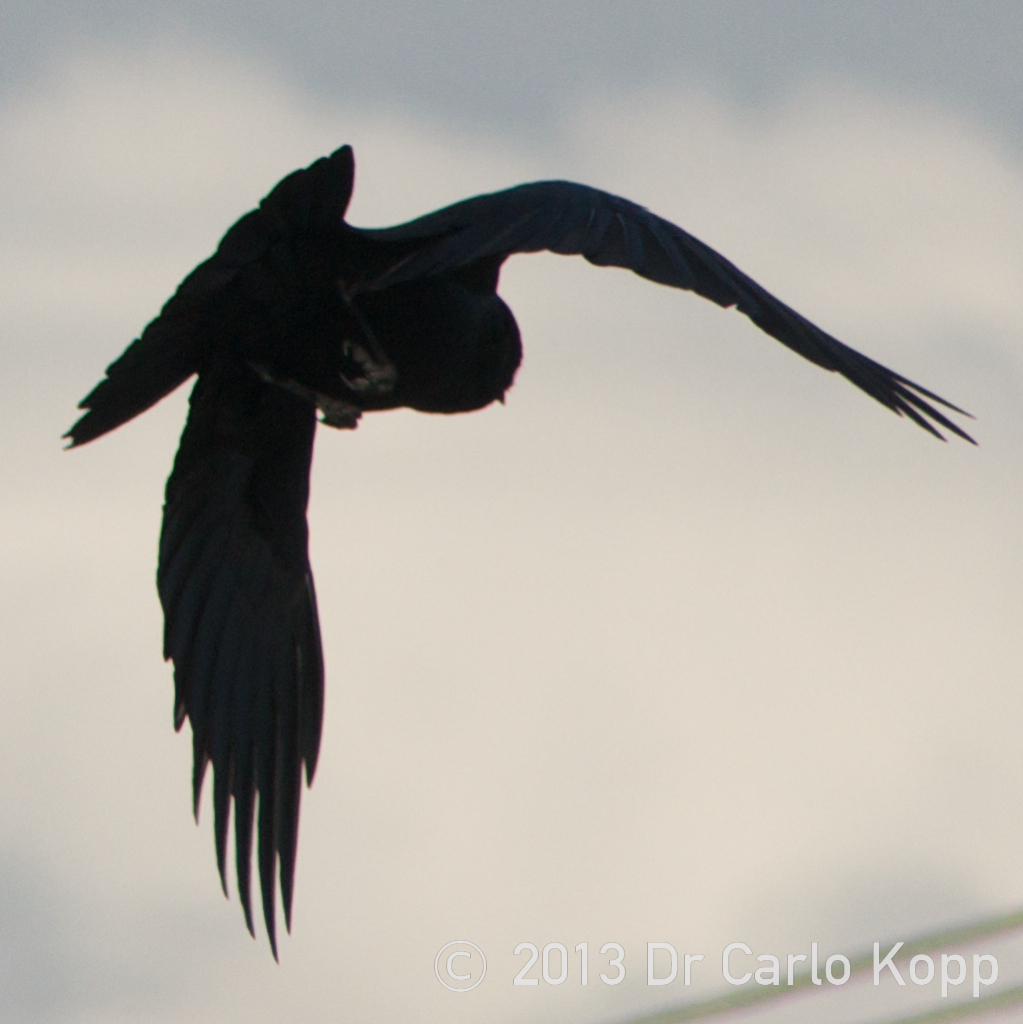
|
Notes on
“Superzoom” Cameras
|

A recent addition to the menagerie of
consumer photographic equipment types in the market are so called
“superzoom cameras”, sometimes also labelled less descriptively as “bridge
cameras”, as they are intended to bridge the gap between consumer
compacts and DSLRs. Most manufacturers offer one or more types in this
class. These are compact, sealed cameras, usually with
one or more
internal image stabilisation mechanisms, and primarily amateur controls
and
operating modes. The depicted Fujifilm
HS10, now obsoleted, is notable as being the first to offer a 30:1
zoom capability, in early 2010.
Superzooms have often been harshly criticised for poor optical quality
compared to DSLR products. This reflects two realities. The first is
that the small consumer grade imaging chips, in the 1/2.5 inch class,
cannot compete
with full frame or APS-C DSLRs in photosite area at similar Megapixel
counts, reflecting in much noisier images. The other reality is that
10:1 out to 30:1 zoom ratios are inevitably at the expense of
optical sharpness, chromatic aberration and distortion performance.
How severe are these limitations? That depends in part on how well the
superzoom has been designed by the manufacturer, and configured by the
end user. The Fujifilm HS10 for instance, performs
poorly in fully automatic Program AE mode at full zoom. Studying images
produced in this mode shows that the algorithm for exposure control
does not appear to account properly for focal length setting, which
results in slow exposure settings, wide open apertures and jitter
induced losses of sharpness - in effect the HS10 algorithm makes much
the same mistakes as an inexperienced human telephoto shooter. Setting
the
HS10 into shutter priority mode, with 1/400 or shorter
exposures, appears to solve this problem, leaving the exposure
algorithms to manipulate aperture controls - unfortunately Auto-ISO is
disabled in the “pro modes” requiring manual intervention to select a
good
ISO choice, and manual adjustment of shutter speed. The results are
considerably better in this regime.
Two HS10 samples at 720 mm equivalent focal length are below. While
noise
performance at 100 ISO is poor, and comparable to a D90 at 1600 ISO,
sharpness is remarkably good, and surprisingly, comparable to a number
of semi-professional DSLR zoom offerings at lower focal lengths. Much
the same has been observed on many other test samples in this mode.
An additional pair of 10242 crops are included, comparing
the same target between the HS10 and D90, at the same 450 mm equivalent
focal length. Sharpness of the Fujinon lens in the HS10 is competitive
at this focal length against the semi-professional grade Nikkor 70-300
mm f/4-5.6D ED, while imaging sensor performance is not. It is
interesting to note that the successor superzooms to the HS10 appear to
use the same lens system, but considerably better 16 Megapixel sensors
and processing.
While the author used the HS10 mostly for documentation applications,
as it
is convenient, small and light (~0.65 kg),
and has good macro modes,
it has been used as a backup on
production shoots and has produced sufficient image quality for less
challenging production print publishing and web applications. While
superzooms will always fall well behind contemporary DSLRs in noise
performance due to the
physics of
imaging
chip size, with good lens design they can provide highly competitive
telephoto performance against cheaper DSLR lenses, providing the ground
rules in lens and camera mode configuration are respected by users.

HS10 720 mm equivalent test target
in Shutter Priority mode at 1/400, f/8.0, -0.66 EV and 100
ISO.

HS10 720 mm
equivalent test target in Shutter Priority mode
at 1/400, f/7.1, -0.66 EV and 100 ISO.

Above, below, comparison of 1:1
crops of identical test target, taken with a super-zoom and
semi-professional DSLR. Upper crop using the HS10 at ~450 mm equivalent
zoom (66.4 mm actual) and f/7.1, 1/640, ISO 100, -0.33 EV and below a
D90 with the Nikkor 70-300 mm f/4-5.6D ED at 450
mm equivalent zoom (300 mm actual), and f/8.0,
1/1000, ISO 320, 0.0 EV. The stabilised Fujinon zoom lens in the HS10,
stopped down, is producing similar sharpness to the unstabilised
semi-professional Nikkor zoom at maximum focal length, where sharpness
is ~60 lp/mm. The most notable difference at this level of detail is
that the noise (and in-camera JPEG sharpening artefacts) at ISO 100 in
the CMOS BSI 1/2.3" sensor is comparable in magnitude to the finer
detail in the image - the superiority of the much larger CMOS APS-C
sensor in the D90 is obvious. The HS10 crop was adjusted for exposure
and colour balance in Aperture 3.


Cropped HS10 production shot at 1/208,
f/4.0, 100 ISO, in fully automatic Program AE using Auto-ISO, at 6.3 mm.
|
|
|



























































